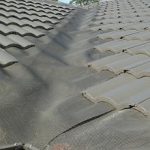 Tile roofs are very durable and beautiful. Traditionally, this type of roofing tile was made out of fired clay, terra cotta or slate. However, today roofing tiles are frequently made out of tinted, molded concrete. Roofing tiles are available in many styles and shapes, including interlocking, fluted, flat, and curved.
Tile roofs are very durable and beautiful. Traditionally, this type of roofing tile was made out of fired clay, terra cotta or slate. However, today roofing tiles are frequently made out of tinted, molded concrete. Roofing tiles are available in many styles and shapes, including interlocking, fluted, flat, and curved.
Tile roofing is an ideal option for roofs that are exposed to salt air or experience hot weather. That is why you frequently see tile roofs in California, coastal Florida, and the Southwest.
Pros of Tile Roofing
Long-lasting: Tile roofs are able to last for more than 100 years, particularly when they are installed on a home or building in the right climate. Concrete and clay tile roofs are able to withstand fire, high winds, and hail. After a tile roof is installed, you won’t need to ever install another kind of roof. A majority of manufacturers offer 50-year warranties.
Insect and rot-resistant: Tiles roofs never decay.
Environmentally-friendly materials: Tile roofs are made out of minerals of the earth and when they are removed they can be pulverized and then recycled.
Energy-efficient: Tiles have a heavy thermal mass that helps with regulating indoor temperatures.
Low maintenance: Leaks are rare and tile roofs also very rarely need maintenance or repair unless they break from heavy impact.
Many choices are available: Tile roofs are available in many materials, styles, and colors that can match any styles of house, ranging from Contemporary European to Medieval. There are some styles that even look like traditional wood shakes or shingles.
The following are some of the many different tile roofing styles that are available:
Spanish tiles are the quintessential Southwest roof. They are best-suited for areas where rain may be infrequent but quite heavy whey they do come. Concrete, terra cotta, and clay tiles are all available in the Spanish tile style.
Double Roman tiles look like Spanish tiles, but there are rows that have distinct ribs. They have more frequently water troughs, although they are smaller. Mediterranean architecture often uses this style of tile roofing. They are most often made out of concrete and are available as well in terra cotta and clay.
Scandia tiles look like inverted Spanish tiles. They provide an appearance of having wide scallop-shaped troughs and sharp vertical ridges. The style is based on northern European architectural styles.
Flat shake tiles normally are made out of concrete and are made to look like wood shakes or granulated asphalt shingles. Slate roofs are basically flat shakes.
As you can see, there are many advantages of tile roofs to consider when choosing your next roof. Consult the friendly team at Roof Restoration Canberra for more information.